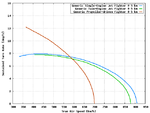Holtzauge,
I know that book, and it's based on memory and wrong data.
The Cd0 of the Me-262 couldn't have been that high.
Plus NACA has lower Cd0 figure for the P-80.
Davparlr,
The P-80 wasn't faster than the Me-262, the Me-262 was faster than the P-80. The P-80A of 1945 with its 17.1 kN engine had a top speed of barely 800 km/h.
As for thrust vs speed:
P-80A top speed at 17.1 kN: 792 km/h
Me-262 top speed at 17.6 kN: 870 km/h
P-80C top speed at 24 kN: 965 km/h
I don't see how the P-80 is cleaner at all.
A good place to read on: ch11-2
A direct comparison: app-a3
As can be seen the Me-262 is able to reach higher Mach levels with lower thrust than the P-80A.
I know that book, and it's based on memory and wrong data.
The Cd0 of the Me-262 couldn't have been that high.
Plus NACA has lower Cd0 figure for the P-80.
Davparlr,
The P-80 wasn't faster than the Me-262, the Me-262 was faster than the P-80. The P-80A of 1945 with its 17.1 kN engine had a top speed of barely 800 km/h.
As for thrust vs speed:
P-80A top speed at 17.1 kN: 792 km/h
Me-262 top speed at 17.6 kN: 870 km/h
P-80C top speed at 24 kN: 965 km/h
I don't see how the P-80 is cleaner at all.
A good place to read on: ch11-2
A direct comparison: app-a3
As can be seen the Me-262 is able to reach higher Mach levels with lower thrust than the P-80A.

